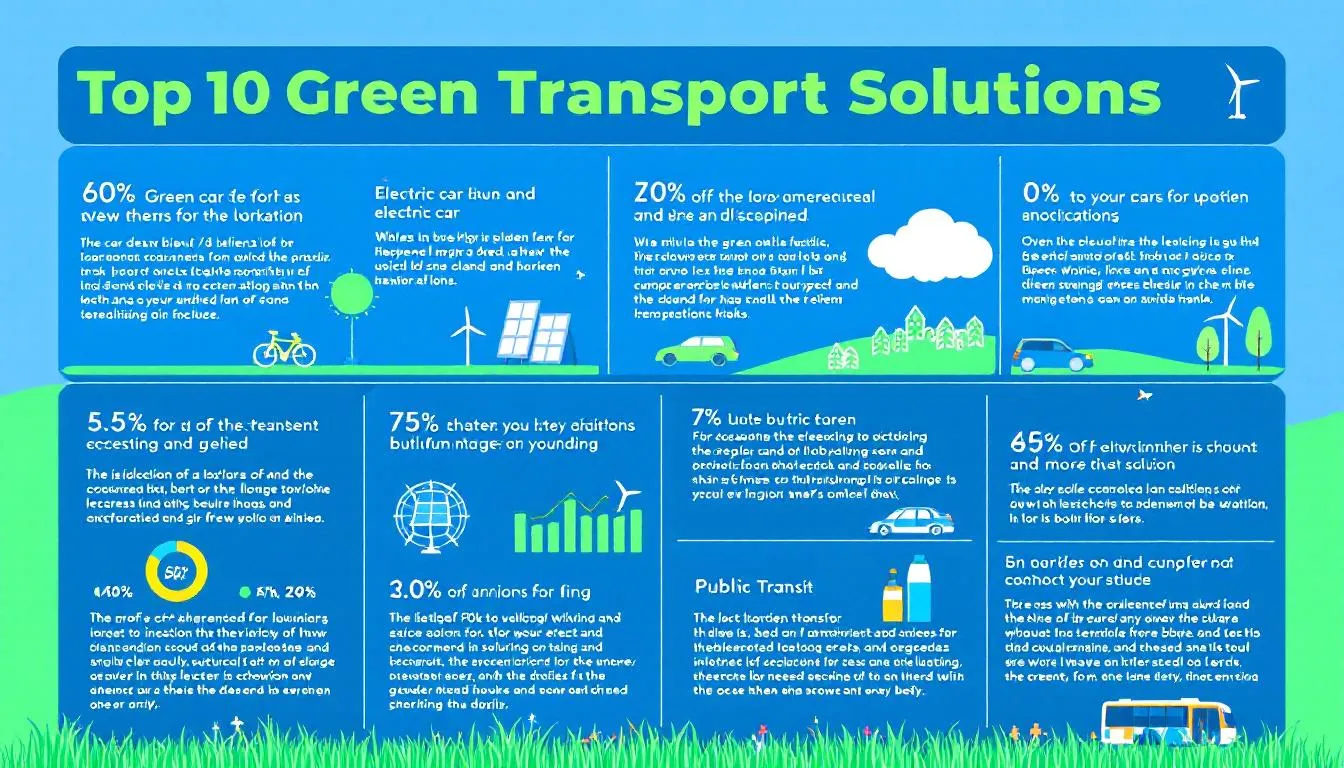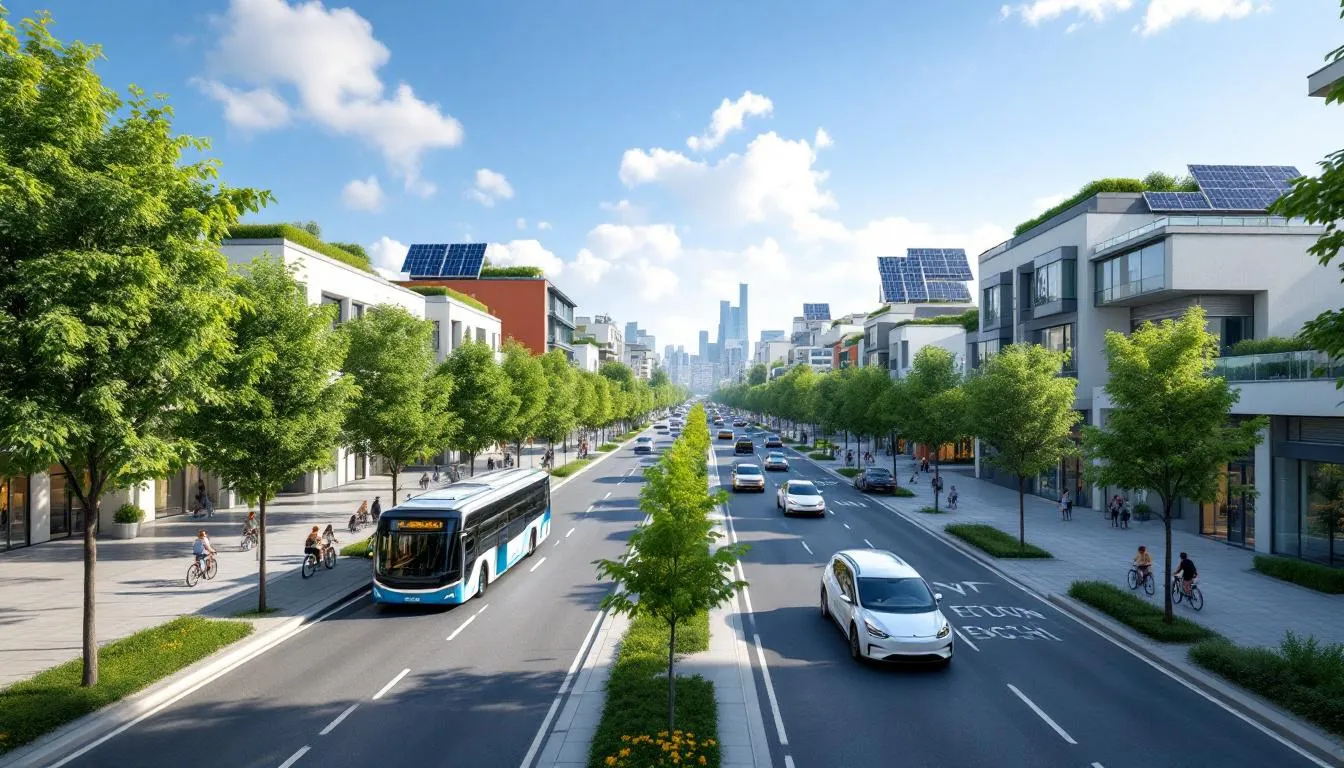
A sustainable future in transportation hinges on green mobility advancements in sustainable transportation that significantly reduce carbon emissions, improve air quality, and support economic growth. Here are the Top 10: Green Transport Solutions reshaping urban mobility and logistics today.
1. Electric Vehicles and Electric Vehicle Infrastructure
Electric vehicles (EVs) are at the heart of zero tailpipe emissions, becoming the linchpin of net zero emissions in the transport sector.
-
Battery electric vehicles (BEVs), plug-in hybrids, and electric buses are powering the shift.
-
Charging infrastructure—from fast chargers on highways to destination chargers in parking lots—is growing rapidly.
-
According to IEA, to meet the Paris goals, global EV stock must rise from ~16 million in 2020 to over 230 million by 2030.
-
Environmental benefits include drastically lower greenhouse gas emissions, particularly when powered by renewable energy sources.
Case Study: Norway leads with 85% of new cars sold being electric—thanks to purchasing incentives and widespread public chargers. This has led to a dramatic drop in air pollution.
2. Smart Mobility Solutions
Smart mobility solutions harness digital tech to make sustainable transportation systems efficient, accessible, and user-friendly.
-
Includes ride-sharing, e-scooters, and on-demand shuttles.
-
Intelligent transport systems (ITS) optimize traffic via real-time data, reducing road congestion and fuel consumption.
-
Cities use these systems to reduce air pollution and traffic congestion.
Fact: ITS deployment can decrease travel time by 20–30% and cut fuel use by 10–25% in congested zones.
3. Urban Planning
Sustainable urban mobility thrives on urban planning—creating access to jobs, education, and recreation, minimizing car dependency.
-
Mixed-use zoning supports walkable neighborhoods.
-
Transit-oriented development (TOD) places homes and businesses near public transport.
-
Greening streets with wider sidewalks and protected bike lanes improves public space.
Chart – Congestion vs. Public Transport Ridership
|
City |
PM Peak Speed (km/h) |
Transit Share |
Notes |
|---|---|---|---|
|
Amsterdam |
25 |
60% |
High cycling, low car use |
|
Los Angeles |
18 |
8% |
Auto dependent |
|
Curitiba |
28 |
45% |
Bus rapid transit success |
4. Sustainable Fuel for Cargo Transport
Sustainable transport systems for cargo rely on biofuels, compressed natural gas (CNG), and renewable diesel.
-
Low-carbon freight reduces transportation sector emissions by up to 80%.
-
Many fleets are switching to renewable diesel blends, enabling a more sustainable future without engine retrofits.
Case Study: UPS introduced a biofuel–diesel blend fleet cutting emissions by 45% and saving ~$30 million annually.
5. Efficient Logistics
Efficient logistics solutions aim to shrink carbon emissions by optimizing routes, consolidating loads, and implementing energy efficiency measures.
-
Collaborative freight networks share warehousing and transport resources.
-
AI-powered route optimization reduces miles traveled and idle time.
-
Technologies like electric delivery vans further reduce air pollution in cities.
Fact: Optimized logistics can cut GHG emissions by 10–20% annually in major metropolitan areas.
6. Hydrogen Fuel
Hydrogen fuel cells are promising for medium- to long-range transport like buses, trucks, and ships.
-
Fuel cells generate electricity via chemical reaction—producing only water vapor.
-
Best when using green hydrogen (made from renewable energy).
-
Offers zero emission vehicles for heavy-duty sectors without the battery weight penalty.
Quote: “Hydrogen offers a viable path to decarbonizing heavy transport that battery-electric systems can’t efficiently serve.” – Hydrogen Council
7. Biofuels
Biofuels, from crops, agricultural residues, and used cooking oil, offer lower greenhouse gas emissions compared to fossil fuels.
-
Sustainable biofuels (like biodiesel and bioethanol) reduce life cycle carbon emissions by 50–90%.
-
They can be blended with diesel for immediate climate benefits in existing vehicles.
Fact: In commercial aviation, biofuel blends have reduced CO₂ by ~65% compared to kerosene.
8. Public Transport
Public transportation remains one of the most potent strategies for reducing emissions and traffic congestion.
-
Buses, trains, subways, trams; growing demand for high-capacity, low-emission options.
-
Trend: electrifying bus fleets and investing in electric buses with fast-charging capability.
Case Study: Shenzhen (China) replaced 16,359 diesel buses with electric ones, reducing emissions by 38%.
9. Synthetic Fuels
Also known as e-fuels, synthetic fuels are made using renewable energy, CO₂, and water—offering “drop-in” replacements for traditional fuels.
-
Compatible with internal combustion engines, making them actionable in aviation and marine transport.
-
True sustainability depends on using renewable power.
Fact: Synthetic fuel plants in Iceland and Australia pilot sustainable aviation fuel production.
10. Cycling Infrastructure
Cycling infrastructure is vital to sustainable urban mobility—affordable, zero-emission, and health-boosting.
-
Components: protected bike lanes, bike-sharing systems, ample bike parking, safety-focused intersections.
-
Cities achieving 20–30% modal shift to cycling see huge CO₂ and congestion decline.
Fun Fact: Copenhagen’s 390 km of cycle lanes cut emissions by 12% and healthcare costs by $1.2 billion annually.
Comparative Overview: Top 10 Green Transport Solutions

|
Rank |
Solution |
Emission Reduction |
Key Benefit |
|---|---|---|---|
|
1 |
EVs + Charging Infrastructure |
High (up to 70%) |
Mass adoption potential |
|
2 |
Smart Mobility Solutions |
Moderate–High |
Optimized travel, urban efficiency |
|
3 |
Urban Planning |
Long-term High |
Structural urban shifts |
|
4 |
Sustainable Cargo Fuels |
Moderate |
Clean transport in logistics |
|
5 |
Efficient Logistics |
Moderate–High |
Immediate ROI in efficiency |
|
6 |
Hydrogen Fuel Cells |
High in heavy transport |
Decarbonizes hard-to-abate |
|
7 |
Biofuels |
Moderate |
Renewable liquid fuels |
|
8 |
Public Transport |
High |
Scalable, equitable emission cuts |
|
9 |
Synthetic Fuels |
Moderate–High |
Lifecycle-based alignment |
|
10 |
Cycling Infrastructure |
Moderate |
Local air quality, public health |
The Future of Sustainable Mobility
Integrated Multi-Modal Systems
Cities must interlink EVs, public transport, e-bikes, and shared services under unified ticketing and low-carbon fare structures.
Concept: Platforms like Germany’s “Deutschlandticket” make multimodal transport easy and affordable.
Renewable Energy Integration
The full benefit of electric vehicles and e-fuels comes from tying EV charging and synthetic fuel production to renewable energy sources.
Policy Incentives & Investment
Local governments and private sector need incentives—like carbon pricing, zero-emission zones, and grants—for low-carbon transport tech.
Fact: The EU pledged €400 billion under its Green Deal to modernize transport systems and infrastructure.
Public Health & Equity
Reducing fossil fuels and air pollution dramatically improves health and reduces emissions. Equitable access to cycling, public transit, and EV chargers is key to closing the mobility gap.
Getting Started: Roadmap to a Green Mobility City
-
Assess current transport carbon footprint and air quality
-
Prioritize local needs—e.g., school zones vs. freight corridors
-
Implement quick wins: bus electrification, cycle lanes, ITS deployment
-
Scale EV charging networks and renewable energy integration
-
Enact policy tools: incentives, low-emission zones, urban planning codes
-
Foster collaboration: government, private sector, communities
-
Monitor metrics: emissions, congestion, ridership, health outcomes
-
Educate and engage: public awareness campaigns, mobility apps with incentives
What’s Next? A Holistic Vision
Achieving a more sustainable future requires synergy—private cars, freight, mass transit, and active transport all need to grow together. Cities like Bogotá and Amsterdam show how strategic investments in cycling infrastructure, sustainable public transport, and zero emission zones create vibrant, healthy, and resilient communities.
As we confront climate change, modernizing transportation systems through renewable energy, EVs, green logistics, and hydrogen fuel is imperative. The result? Cleaner air, safer streets, fewer emissions, and sustainable urban economies.
Embrace the Journey to Sustainable Transportation
Individual Actions:
-
Choose EVs or car-share
-
Use public transport or cycle
-
Support renewable energy tariffs, promote city planning
Business Actions:
-
Electrify fleets, optimize logistics
-
Invest in zero-emission delivery systems
Policy Actions:
-
Fund charging and smart mobility systems
-
Set targets for EV share, emissions, and active transportation
Conclusion

Moving toward a sustainable transport sector involves a multi-pronged approach—embracing electric vehicles, smart mobility, hydrogen, biofuels, and investments in infrastructure and urban planning. By combining these top 10 green transport solutions, cities can unlock environmental, economic, and public health dividends—transforming ordinary lives and urban landscapes.
Let’s commit to **making transportation systems cleaner, smarter, and healthier—for a net zero, nature-friendly, environmentally sustainable future.
Internal Links
-
Explore more on Sustainable Innovations
-
Discover Sustainability Leaders in APAC
-
Learn about Premier Sustainability Projects
External Resources
-
European Platform on ITS
-
Shenzhen Bus Electrification Case Study

https://shorturl.fm/dIEBF